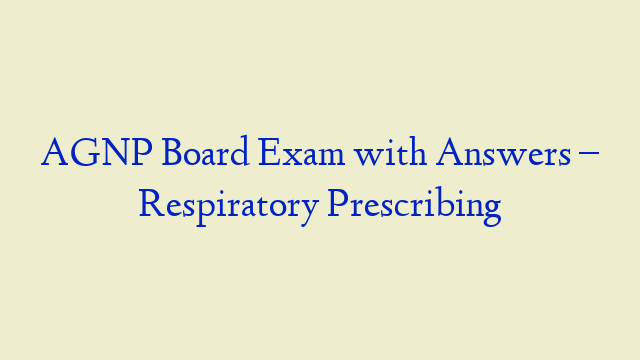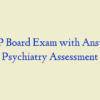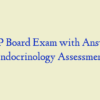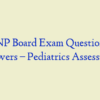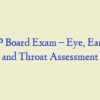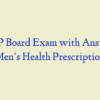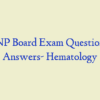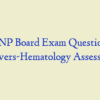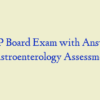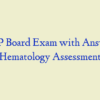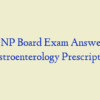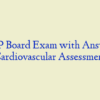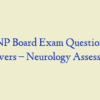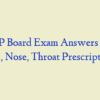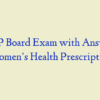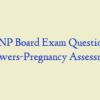Description
AGNP BOARD EXAM QUESTIONS Respiratory Prescribing (Questions 100)
- Treatment of Bordetella pertussis in a patient with hypersensitivity to macrolides is:
- The mainstay of treatment in the management of mild and moderate croup is symptomatic relief that includes:
- In adults with community-acquired pneumonia in which B-lactamase producing Haemophilus influenzae is identified as the causative organism, the outpatient treatment of choice is:
- A patient with sinusitis is treated with amoxicillin. Caution is advised with concomitant use of:
- A patient with bacterial sinusitis taking an oral penicillin should be instructed:
- An example of a beta2-adrenergic receptor agonist used in the treatment of asthma is:
- Benzonatate (Tessalon Perles), a non-narcotic antitussive,:
- Which of the following medications, when combined with pulmonary rehabilitation, enhances exercise performance?
- Which of the following would NOT be a potential adverse reaction of an intramuscular corticosteroid?
- Doxycycline (Vibramycin), for the treatment of pneumonia, is classified as a:
- The main side effect related to the use of long-acting antimuscarinic antagonists is:
- Theophylline (Theo-24) relaxes bronchial smooth muscle and:
- Fluticasone/salmeterol is a combination inhaler that is branded as:
- The initial bronchodilator in the treatment of chronic bronchitis is:
- The treatment of choice in the outpatient setting for an adult with community-acquired pneumonia caused by Mycoplasma pneumoniae or Chlamydophila pneumoniae is a:
- A patient with diabetes who is started on corticosteroids for the treatment of chronic bronchitis exacerbation should be instructed to monitor for:
- The beta2 adrenergic receptor agonist most commonly used to prevent bronchospasm associated with exercise-induced asthma is:
- Levofloxacin, for the treatment of community acquired pneumonia, is classified as a:
- When considering the use of theophylline to treat chronic bronchitis, its use is limited due to:
- Patients with severe emphysema who are receiving chronic inhaled steroids are at increased risk of developing:
- For the treatment of a patient experiencing bronchospasms in response to an allergen, the LEAST favorable route for the administration of epinephrine, a catecholamine, is:
- Tiotropium (Spiriva HandiHaler), used in the treatment of chronic bronchitis,:
- Which of the following is NOT a potential side effect of albuterol (ProAir HFA)?
- When prescribing a macrolide such as erythromycin for a patient with strep pharyngitis, the patient should be informed that they may experience:
- According to the Global Initiative for Chronic Obstructive Lung Disease (GOLD) guidelines, oral prednisone for an acute exacerbation of emphysema should be administered for:
- With the use of tiotropium (Spiriva HandiHaler), the patient should be instructed that:
- Caution is advised when theophylline (Theo-24) is prescribed for patients with a history of:
- Dextromethorphan, a cough suppressant, is safe to administer to patients who have:
- Glucocorticoids are indicated for the treatment of:
- For asthma symptoms requiring use of a short-acting bronchodilator more than 2 times a week, the preferred addition to the treatment regimen is:
- Amoxicillin/clavulanate (Augmentin), a beta-lactam antibiotic,:
- An example of an inhaled glucocorticoid used in the treatment of asthma is:
- Which statement is NOT true about beta2-agonists?
- The mechanism of action of inhaled glucocorticoids in the treatment of chronic obstructive pulmonary disease is to:
- Robitussin DM is a combination of dextromethorphan and:
- Leukotriene antagonists such as montelukast (Singulair) should not be prescribed if the patient has preexisting:
- Doxycycline (Vibramycin) is the preferred treatment of pneumonia caused by:
- Which of the following medications is classified as a short-acting antimuscarinic antagonist (SAMA)?
- For asthma symptoms occurring daily with nighttime symptoms greater than one time per week, the preferred daily treatment is a:
- When used in the treatment of chronic obstructive pulmonary disease (COPD), macrolides:
- Which medication is classified as a xanthine?
- Bactrim DS can be used to treat a patient with pneumonia. The “DS” in trimethoprim-sulfamethoxazole (Bactrim DS) stands for:
- Theophylline (Theo-24) may have an effect on the serum concentrations of:
- The recommended treatment for community-acquired pneumonia secondary to an atypical pathogen in a previously healthy patient who has a macrolide allergy is:
- Routine management of bronchiolitis in moderately ill children includes:
- The brand name for albuterol (inhaled) is:
- The mechanism of action of short-acting antimuscarinic antagonists (SAMA) such as ipratropium is to:
- Azithromycin (Zithromax) and other macrolides are safe to administer with:
- The initial recommended treatment for uncomplicated acute bronchitis in adults is:
- Doxycycline (Doryx), for the treatment of pneumonia,:
- An example of a long-acting bronchodilator is:
- The most common symptom of theophylline toxicity is:
- The generic name for Tessalon Perles, used to treat cough, is:
- Albuterol (ProAir HFA), used in the treatment of asthma, causes bronchodilation by:
- Patients who are already on tiotropium (Spiriva) for chronic obstructive pulmonary disease should not take a(n):
- The antibiotic of choice in the management of Bordetella pertussis in all age groups is:
- Which of the following scenarios would NOT warrant monitoring of a serum theophylline level?
- The peak blood levels for trimethoprim and sulfamethoxazole contained in Bactrim DS are approximately:
- Benzonatate (Tessalon Perles), used to treat cough, is classified as a(n):
- Montelukast (Singulair), a leukotriene inhibitor, is:
- Which of the following is a short-acting bronchodilator?
- Albuterol (ProAir HFA) is NOT recommended for use in the treatment of:
- Toxic effects of theophylline (Theo-24) may be increased by:
- When used in the treatment of lower respiratory tract infections, macrolides:
- With acute exacerbation of bronchitis, inhaled steroid use should be:
- Which of the following is a combination long-acting beta2-agonist and an inhaled steroid?
- Potential drug-drug interactions may occur when albuterol is combined with:
- Which medication is NOT appropriate treatment for exercise-induced asthma?
- An indication for the use of beta2 adrenergic receptor agonists is:
- A patient who is receiving warfarin (Coumadin) requires the initiation of doxycycline (Doryx) for the treatment of pneumonia. The nurse practitioner knows that:
- In children between the ages of 5-11, the long-term use of which asthma medication may cause a transient slowing of growth?
- The primary antibiotic option for suspected pneumocystis pneumonia (PCP) in a patient with HIV infection is:
- Which asthma medication does NOT directly exhibit an anti-inflammatory action?
- In the treatment of chronic obstructive pulmonary disease (COPD), common side effects of corticosteroids may include:
- Which of the following is an adrenergic drug that acts on the sympathetic nervous system?
- Prolonged use of corticosteroids in children generally does NOT lead to:
- Levofloxacin (Levaquin) is associated with potentially serious side effects, including:
- The likelihood of a drug-related rash is increased when Augmentin is administered to a patient with a:
- Patient instructions for the use of inhaled steroids would NOT include to:
- Long-acting bronchodilators, such as salmeterol (Serevent Diskus), are indicated in the treatment of:
- Inhaled antimuscarinic agents, such as ipratropium bromide (Atrovent HFA),:
- The patient’s use of inhaler technique should be evaluated:
- The mechanism of action of dextromethorphan is to:
- Xanthines such as theophylline, used in the treatment of COPD, cause bronchodilation by:
- Unless contraindicated, all patients with a diagnosis of emphysema should receive:
- Levofloxacin (Levaquin) should be avoided in patients with a history of:
- Which of the following medications is slowly and incompletely metabolized by the liver and excreted largely unchanged in the urine within 24 hours of oral administration?
- For complaints of dysphonia related to the use of mometasone (Asmanex Twisthaler), the patient should be advised to:
- For previously healthy children with mild to moderate symptoms of suspected bacterial community-acquired pneumonia secondary to Streptococcus pneumoniae, the first-line therapy is:
- Montelukast (Singulair) is more than 99% bound to plasma proteins, extensively metabolized and eliminated via:
- For the treatment of chronic bronchitis, macrolides are contraindicated in patients who:
- Which of the following is an muscarinic antagonist for use in exacerbations of chronic bronchitis?
- Montelukast (Singulair) blocks or inhibits the action of:
- When treating a patient with amoxicillin, he should be instructed to take the medication:
- A patient with pertussis is allergic to macrolide antibiotics and is being treated with trimethoprim sulfamethoxazole. She does NOT need to be monitored for:
- Which medication has the greatest effect on the reduction of emphysema exacerbations?
- In Augmentin, amoxicillin and clavulanate are combined. The action of clavulanate is to:
- In the treatment of pneumonia, a macrolide such as clarithromycin should NOT be coadministered with:
- In an acute upper respiratory infection, beta-lactam antibiotics:
- Which of the following medications does NOT produce bronchodilation?
